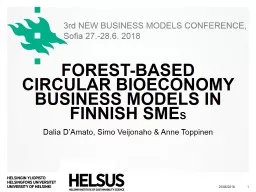

amp Anne Toppinen FORESTBASED Circular bioeconomy Business models in Finnish SME s 25062018 1 3rd NEW BUSINESS MODELS CONFERENCE Sofia 27286 2018 Current human ID: 788887
Download The PPT/PDF document "Dalia D’Amato, Simo Veijonaho" is the property of its rightful owner. Permission is granted to download and print the materials on this web site for personal, non-commercial use only, and to display it on your personal computer provided you do not modify the materials and that you retain all copyright notices contained in the materials. By downloading content from our website, you accept the terms of this agreement.
Slide1
Dalia D’Amato, Simo
Veijonaho & Anne Toppinen
FOREST-BASED Circular bioeconomy Business models in Finnish SMEs
25/06/2018
1
3rd NEW BUSINESS MODELS CONFERENCE, Sofia 27.-28.6. 2018
Slide2Current
human economic
activities coupled with
population growth are unsustainable and demand fundamental changes in consumption-production systems (MA, 2005;
Rockström et al. 2009).Circular economy and bioeconomy strategies being developed in Europe and Finland (The Finnish bioeconomy strategy, 2014; Leading the Cycle, 2016)Transition to circular bioeconomy
suggested to support Sustainable Development Goals (Hetemäki et al., 2017)
Businesses as key
enablers of such transition, especially
SMEs (Bocken et al. 2014; Hansen, 2016)
25/06/2018
2
Introduction
Slide3AIM OF THE STUDY
To examine circular bioeconomy business models by Finnish
SMEs and their contribution to sustainability:How do SMEs propose, create and deliver, and capture value through circular bioeconomy business models?
How does circular bioeconomy business models
provide beneficial outcomes relative to sustainable development?
25/06/20183
Slide4CIRCULAR BIOECONOMY?Circularity
principles in the use of biomass resources
(e.g. biomass cascading, waste hierarchy
); longer lifespan and higher endurance for bio-based products/services,
could be more sustainable than the bioeconomy and the circular economy alone (Hetemäki et al., 2017)
25/06/2018
SOURCE:
Antikainen et al. 2017
Slide5Data and methods8 companies selected by purposive sampling from
Focus on forest-related products/services: packaging,
biomaterials, textiles, biotech and
pharmaceutical products…Qualitative
analysis of interviews with
company managers25/06/20185
Slide6RESULTS
25/06/2018
6
Sustainability needs combinations of the archetypes (
Bocken
et al., 2014)
Slide7DISCUSSION
Technological archetype models were distinctly predominant over social and organizational models (similar findings Bocken et al., 2017)
Transition
to a circular
bioeconomy in the context of forest-based industry is lagging (Antikainen et al., 2017; Hetemäki et al., 2017)
Results suggest that social benefits are still taken as a narrow outcome of environmental and economic values – future research area to conceptualize better25/06/20187
Slide8Conclusion
Circular bioeconomy business model according to this study:
Value proposition:Substituting unsustainable materialsValue creation & delivery:Using forest-based raw materials with new production technology in strong network of partners
Value capture:Reducing the environmental footprint in productionSavings on fixed costs from
partnering
25/06/20188
Slide9References
Antikainen
, R.,
Dalhammar, C.,
Hildén, M., Judl, J.,
Jääskeläinen, T., Kautto, P., Koskela, S., Kuisma, M., Lazarevic, D., Mäenpää, I., Ovaska, J-K., Peck, P., Rodhe, H., Temmes, A., Thidell
, Å., 2017. Renewal of forest based manufacturing towards a sustainable circular
bioeconomy
. Reports of the Finnish Environment Institute 13/2017.
Bocken, N.M.P., Short, S.W., Rana, P., Evans, S., 2014. A literature and practice review to develop sustainable business model archetypes. J. Clean. Prod. 65, 42-56. doi:10.1016/j.jclepro.2013.11.039
Hansen, E., 2016. Responding to the
Bioeconomy: Business Model Innovation in the Forest Sector, in: Kutnar, A., Muthu, S. (Eds.), Environmental Impacts of Traditional and Innovative Forest-Based
Bioproducts
. doi:10.1007/978-981-10-0655-5_7
Hetemäki
, L. (Ed.), 2017. Future of the European Forest-Based Sector: Structural Changes Towards
Bioeconomy
. What Science Can Tell Us, No. 6. European Forest Institute.
Leading
the cycle, 2016. Finnish road map to a circular economy 2016–2025.
Sitra
.
MA
- Millennium Ecosystem Assessment, 2005. Millennium ecosystem assessment synthesis report.
Oghazi
,
Pejvak
,
Mostaghel
, R., 2018. Circular Business Model Challenges and Lessons Learned—An Industrial Perspective. Sustainability 10, 1–19. doi:10.3390/su10030739
Reim
,
Wiebke
,
Sjödin
, David,
Parida
,
Vinit
,
Rova
, Ulrika,
Christakopoulos
, P., 2017. Bio-economy based business models for the forest sector – A systematic literature review. Proceedings of the 8
Th
International Scientific Conference Rural Development.
Rockstrom
, J.E.A.,
Steffen
, W.,
Noone
, K., Al., E., 2009.
A safe operating space for humanity. Nature 461, 472–475. doi:10.1038/461472a
The
Finnish
bioeconomy
strategy, 2014. Finnish Ministry of Employment and the Economy.
25/06/2018
9
Slide10Thank you!
25/06/201810
FOLLOW OUR RESEARCH
group
FOREST BIOECONOMY, BUSINESS AND SUSTAINABILITY
@FBBS_UH